Wednesday, August 22, 2012
Mark and Gaz
Succulents are usually associated with dry, open, and sunny locations. Or at least in arid gardens and gravel borders (or containers) sited in a sunny spot with good drainage of which xerophytes need in order to thrive well.
Not so much in a woodland garden under the canopy of trees of which it will be under shade for most parts of the day.
But that's how I found some succulents growing in the beautiful woodland garden of Tregrehan.
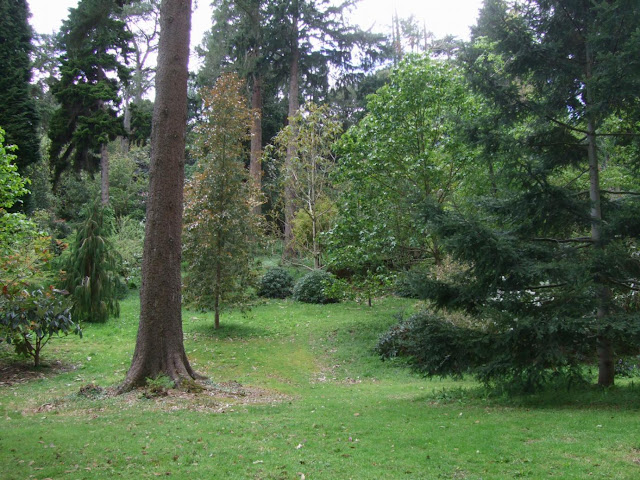 |
| The woodland garden of Tregrehan |
Talking to the owner of Tregrehan, plantsman and modern plant hunter Tom Hudson a couple of years ago, this is a sort of experiment to see which xerophytes will do well in a woodland garden, where they will be under the canopy of large trees and only getting some sun during parts of the day.
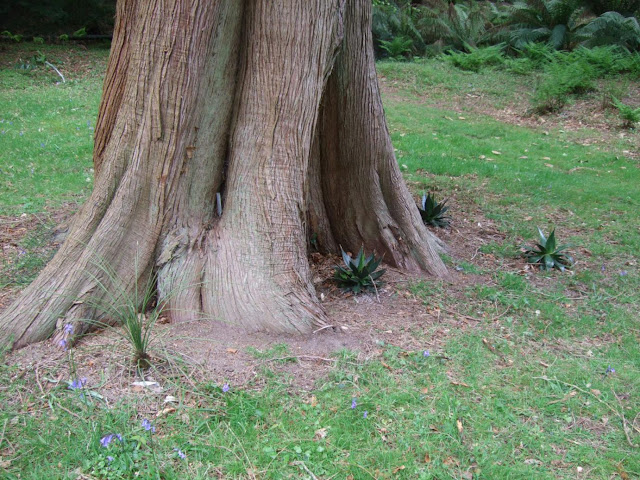 |
| Left - Dasylirion quadrangulatum, Right - three Agave montanas |
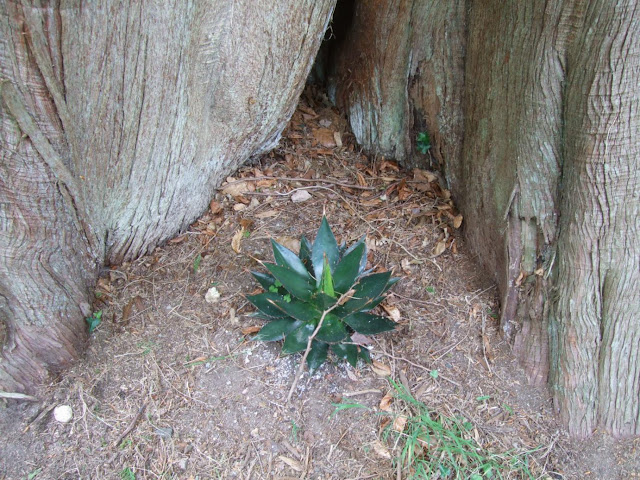 |
| Agave montana |
The area where most of these xerophytes are in a semi clearing, under very tall tress where by its sheer size and height, allows some light onto their bases. So they are not totally in the dark. Also, the trees use up any excess moisture from the ground, which compensates for the drainage requirement not usually met by planting xerophytes directly unto soil. And during the winter, the canopy of the trees provide some shelter the plants underneath them.
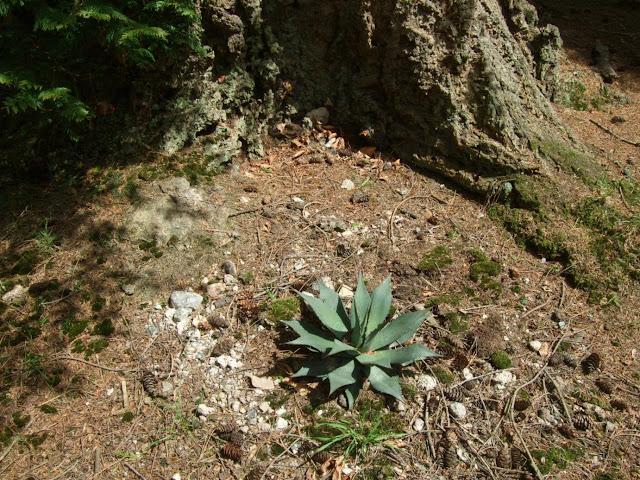 |
| Agave gentryi |
 |
| Nolina nelsonii |
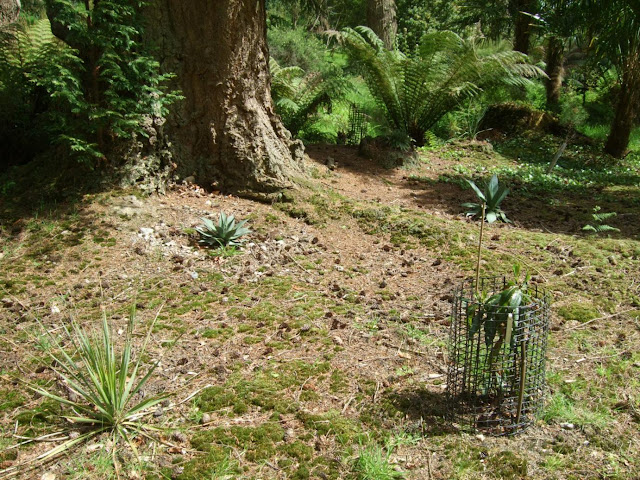 |
| Far left - Nolina parviflora, Middle - Agave gentryi, Far right - Agave montana |
Tregrehan benefits from being in a mild location, where a lot of exotic plants can thrive while in most parts of the UK this is not possible without giving them extra protection during the winter. Despite the sheer size of the place, where he can easily allocate a certain area for a full on, large scale xerophytic planting, he feels it is not the right type of garden for one. The garden has a long standing reputation for being a woodland garden, full of mature and exotic trees and shrubs, of which he is keen on maintaining that way.
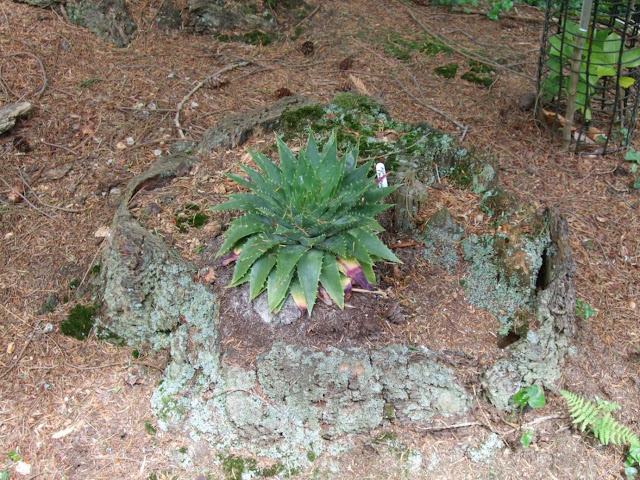 |
| Aloe polyphylla |
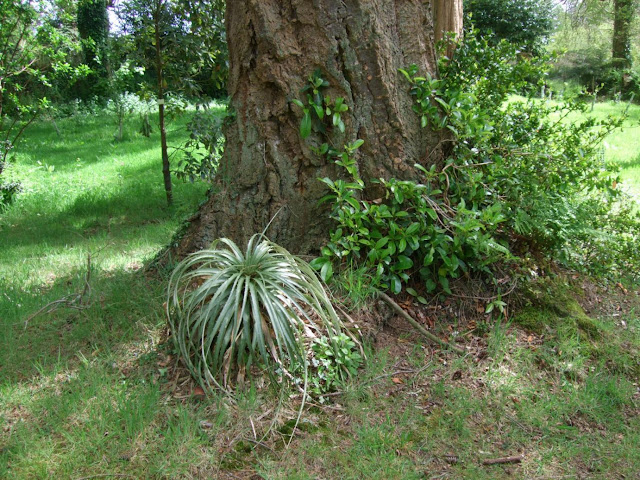 |
| Puya chilensis |
So no arid beds in this garden I'm afraid, not even in the future, unlike other Cornish valley gardens. But there is a room for a select few as long as they do well within the woodland area.
It is more than just 'plant and see how it goes' though, as some of the one planted were originally collected from areas where they were growing under a forest canopy (like the Agave montana amongst others), so in theory they should be fine where they are sited now. A few are pure experiments of course, but you'll never know until you try it!
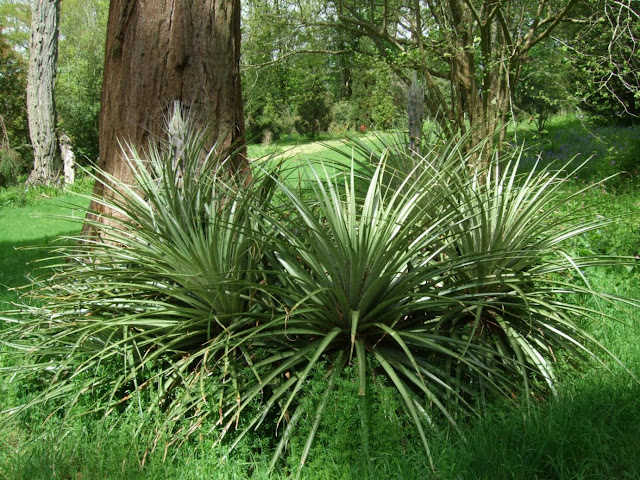 |
| A larger clump of Puya chilensis, with one about to flower |
So far so good. We've been to this garden several times and haven't noted any obvious casualties and some of the specimens have bulked up considerably since we first saw them a few years ago. As I've said, you'll never know until you try it and you'll definitely learn something from it.
Is it applicable to a small garden though? Yes, very much so. If you have a sheltered area in the garden (a courtyard garden also springs to mind) that only gets some sun on parts of the day and is shady most of the time, some xerophytes might still do well in those areas and worth giving them a try. Like the ones at Tregrehan.
Mark :-)
Email This
BlogThis!
Share to X
Share to Facebook
Share to Pinterest












 This gardening blog follows our journey as we create our Tropical and Exotic themed garden. We hope you'll enjoy the journey as much as we do. We started our Exotic Garden in 2005 and this site will show its development, as well as our travels, both abroad and within the UK to gardens, nurseries and friends.
This gardening blog follows our journey as we create our Tropical and Exotic themed garden. We hope you'll enjoy the journey as much as we do. We started our Exotic Garden in 2005 and this site will show its development, as well as our travels, both abroad and within the UK to gardens, nurseries and friends.













This is a great post. Most people think succulents need full sun all day long. The truth is that many of them actually prefer some shade, especially during the hottest time of the day (probably not so much an issue in the U.K. where it's never THAT hot). I'd love to know how the succulents at Tregrehan fare over the medium to long term, so please keep us posted.
ReplyDeleteI wouldn't want to have to remove dead leaves and other debris from those puyas!
ReplyDeleteNot sure if this mixture works for me, but thanks for the post it was very informative.
ReplyDeleteThat is a neat looking place to visit. It's nice what all they've done with what they have.
ReplyDeleteCher Sunray Gardens
Very interesting! I've been thinking about the Agaves that I unintentionally planted near the base of winter thirsty shrubs. Not something you'd see in their natural environment but perhaps a key in keeping them alive in a winter wet location. Please do post about this garden from time to time, I'd love to know how it does long term.
ReplyDeleteOof those Puyas!
ReplyDeleteAlso, those Agave montana that seem to do ok at the foot of trees do make me feel a bit more confident about the Agave parryi that I experimentally planted in the very dry bed under an old Chinese juniper this spring.
Yes, a lot of plants can thrive in those conditions. And there really are plants which are really very difficult to kill, and those plants fit perfectly in those conditions. Now i remember the Sansevierias, Dieffenbachia, Marantha, etc.
ReplyDeleteVery interesting...it seems so odd at first...but sort of makes sense after you think about it for a bit :-)
ReplyDeleteSmart to put them under trees that will suck up excess moisture. Shade is a must for Agaves in places like Arizona, surprisingly enough. Most Agaves are high-altitude where at least the nights cool off in summer--habitat photos from Mexico show many many Agaves growing happily in shade--just not under such very UK-looking trees, on the edge of velvety lush UK-looking lawns...
ReplyDeleteWill keep you guys posted on how those succulents get on, as we visit this garden at least once a year so can do updates from time to time.
ReplyDeleteThe general lack of summer heat in the UK can be an issue for most of these xerophytes, as well as the damp winters and low temps which can persist during the winter, sometimes even days on end without any warm daytime temps/intervals to compensate for it. To give the best possible chance for them in the UK they are best sited in full sun, good drainage, receives winter sun too.
There are areas though that are generally milder than the rest of the UK, like where Tregrehan is and they can get away with a bit more, like siting xerophytes in shadier spots.
I understand that in hotter parts of the world, where it gets really hot especially during the day and in summer, these xerophytes even go dormant with the intense heat and growth ceases. In these places xerophytes perform and thrive better with some shade and under the canopy of other plants, rocks, and within crevices. The ambient heat is enough to sustain them long term, together with a drier atmosphere, even experiencing cold evening temperatures, they do well. Especially if the daytime temps are relatively warm. Agaves coming from colder regions that get snow, they do fine even when submerged in it for months as its the right kind of snow-dry and dusty- unlike here which is wet and icy, penetrating the plant and killing it. Hence it's extra tricky to get xerophytes thriving well in the UK.
ReplyDeleteAesthetics is a another dimension of it though, and a subjective matter that is fascinating to discuss and hear opinions about. The woodland and xerophyte combo won't appeal to everyone. Personally I think the Aloe polyphylla looks like its struggling in its spot. Still it's worth trying some succulents in shadier spots, weighing all the other factors in :) great replies guys which I enjoyed reading too!
Fascinating post. I'm not sure that it works from an aesthetic point of view even if it's sound enough as a concept. I must get down there sometime to see for myself.
ReplyDeleteVery interestingI would never expect to see Agaves growing in such conditions.I only recently came across your blog and think its superb.I look forward to following it.
ReplyDeleteMark and Gaz...Puya chilensis but without spikes is what I have that needs a home!! Let me know if you saw the pictures....I have two ;)
ReplyDeleteThanks John, when you get the chance do so, you'd enjoy wandering down there :)
ReplyDeleteThanks Richard, glad you found our blog :)
Motormouth, will check email and let you know soon, many thanks! :)
What a beautiful woodland garden! No, I would not think to plant succulents under the trees, but in the dry soil near tree trunks may be just the place. It is an interesting idea, though for me, I suspect most would hate my humid atmosphere. But if we don't test the limits, how can we learn?
ReplyDeleteThat's a beautiful looking garden - with some strange bedfellows! An interesting experiment, and the unexpectedness certainly makes you look twice.
ReplyDeleteIndeed Debs, if you don't test a few things how would one know :)
ReplyDeleteIt is a beautiful garden indeed Janet, with a few unusual surprises here and there like these succulents on the base of trees :)
This is a great post and inspires me to sprinkle a couple agaves under some old Douglas fir on Saltspring Island. It's always hard leaving out marginal plants to the test! A subtle guilt in anticipation of success or failure.
ReplyDeleteyes - I saw these earlier in the year and felt they looked very odd. It didn't work for me. I haven't checked out exactly what was there but guess most were desert species as are most succulents, rather than woodland. When I was there the Puyas were actually in full flower and I have to admit they looked splendid and seemed to be thriving.
ReplyDeleteBeautiful Puya shots, Mark! Are you planning to repeat the experiment in your garden around your new pond?
ReplyDeleteHi, thanks for the comment on my blog and great to see your lovely blog. This post attracted me immediately. Really nice. LT
ReplyDelete